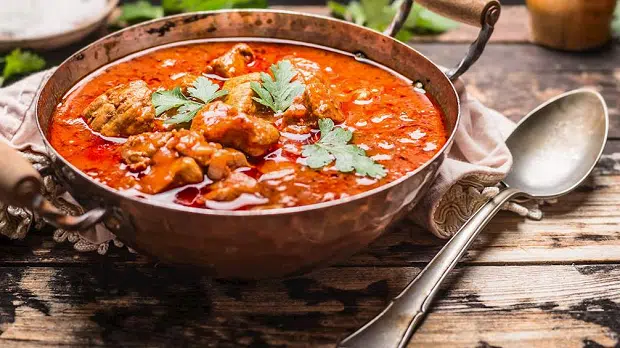Are you planning to travel to Belgrade? In that case, we present our guide: Best Serbian Food to try in Belgrade. So, if you want to know what to eat there, stay with us.
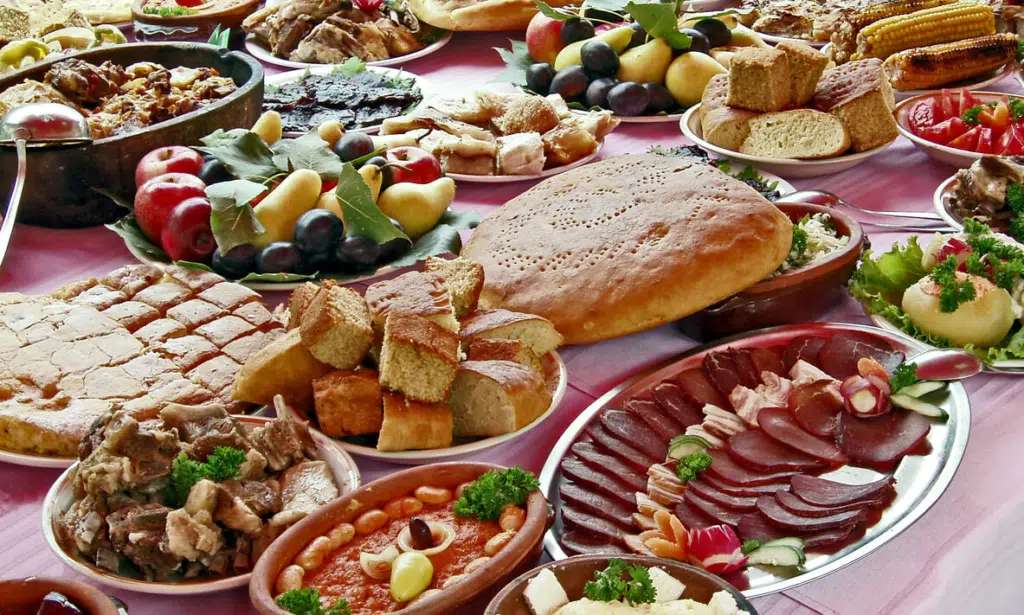
©rakijagrill.com
Introduction to Best Serbian Food
Belgrade boasts a rich cultural history, and Serbian cuisine reflects this fact. The country’s dishes have been influenced by various cultures that have left their mark on Europe and other parts of the world. Positioned at the crossroads of East and West, Serbia’s cuisine features traditional dishes shaped by Middle Eastern and European influences.
Furthermore, Serbian cuisine is a unique culinary experience. It is an excellent choice for travelers seeking something new while exploring this stunning Southeast European country, especially for meat eaters.
Most Popular Serbian Dishes
Serbia may not be the first place that comes to mind when considering Europe’s ultimate foodie destination, but it should be noticed. However, Serbian Food is delicious. After all, the country offers a variety of Balkan classics, pepper-based side dishes, and doughy desserts, among other delights. Serbian cuisine originates from Eastern European traditions with Greek, Turkish, and Mediterranean food influences. Hearty stews, soups, meats, and vegetables are staples in many dishes. As with other Eastern European cuisines, Paprika is the most commonly used spice in Serbian cuisine.
Serbians strongly appreciate food and consider it an integral part of their homes. Visitors can expect to be offered treats repeatedly, and generous portions are standard in all restaurants. It is recommended to sample the local dishes in a cozy kafana (a traditional tavern serving coffee, drinks, snacks, and small meals) or try traditional at a trendy restaurant like Ambar.
Without further ado, here are the must-try dishes of Serbia that you should experience for yourself.

©tasteatlas.com
Sarma
Sarma is an essential dish in traditional Balkan cuisine and is often considered one of the best Serbian Foods to try. It comprises a filling that is enclosed by various leaves or leafy vegetables. While this dish has many versions, the filling typically includes minced meat, rice or bulgur, herbs, seasonings, red pepper, Paprika, ground sumac, or tomato sauce. The wrapping is usually made with vine, cabbage, sauerkraut leaves, or various leafy vegetables such as collard greens and Swiss chard.
Originally from the Ottoman Empire, Sarma is a trendy dish in the Balkans, Central Europe, the South Caucasus, and the Middle East. It is ideal for a filling lunch or dinner, especially in winter. But it is also served on special occasions and holidays.
Plain yogurt, mashed potatoes, and crusty bread typically accompany Sarma.
According to food critics, the best Sarmas in Belgrade are served in To je to, Tri Šešira, Klub književnika, and many others.

©cookingtheglobe.com
Ajvar
The Balkans and Eastern Europe are home to a famous relish called ajvar. The ingredients of this traditional dish include red bull horn pepper, hot pepper, eggplant, and garlic, with the amounts of each varying based on personal preference. Upon being roasted over a wood fire, the vegetables acquire a pleasant smokiness that complements the sweetness and tanginess of the relish. While many types of ajvar exist, the Macedonian version that exclusively uses red peppers is highly prized.
The name “ajvar” is derived from the Turkish word “havyar,” which means caviar. Serbia was once a significant caviar exporter of farmed Black Sea beluga (sturgeon). However, when caviar production decreased, the Serbians began producing a vegetable caviar known as “red ajvar.” The relish is an ideal accompaniment to grilled meats.
You can taste the best Ajvar at Ambar Belgrade or Tri Šešira.
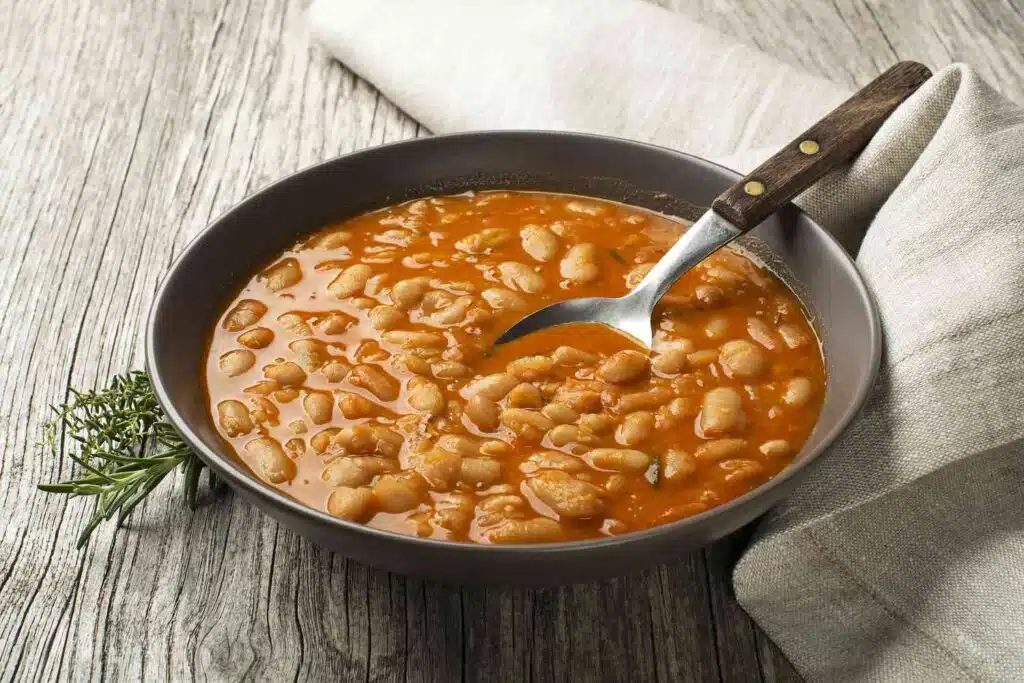
©thespruceeats.com/Getty Images
Pasulj
Pasulj is a widespread Serbian bean soup, traditionally made with white beans. The beans are usually simmered in this soup with sausage, bacon, ham, and vegetables like onions and carrots. Paprika, bay leaves, and garlic are the common seasonings used to flavor the soup.
Pasulj is a typical example of Serbian comfort food, and it is also well-known throughout the Balkans, especially in the neighboring countries. It is best enjoyed with some crusty bread or sliced raw onions on the side.
People from Belgrade say that they make the best Pasulj at Careva ćuprija.

©coolinarika.com
Karađorđeva šnicla
Karađorđeva šnicla is a traditional Serbian dish consisting of veal or pork cutlet filled with kajmak, then rolled in breadcrumbs and fried in hot oil. The cutlet was created in 1956 by a chef, Mića Stojanović, who would later become a personal chef to Josip Broz Tito, the president of the former republic of Yugoslavia.
The chef claims he invented it out of necessity at the restaurant Golf in Belgrade and named it after the Serbian Prince Karađorđe. Today, the dish is a staple at many traditional restaurants. Roasted potatoes, a lemon wedge, and tartar sauce typically accompany it.
The other name, devojački san (maiden’s dream), refers to the phallic shape of the dish.
Best Karađorđeva šnicla is served at Tri Šešira.
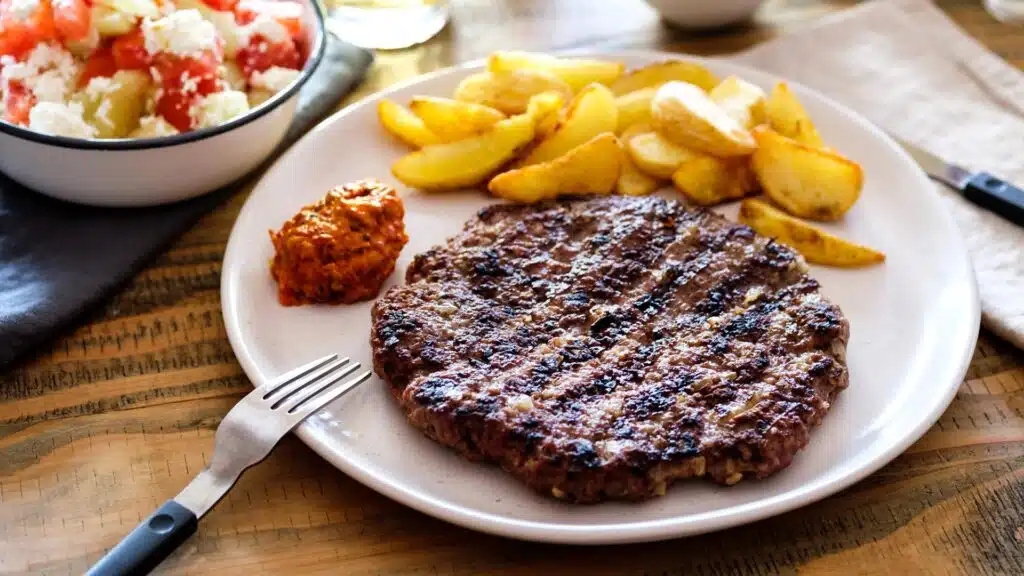
©volim-meso.hr
Pljeskavica
Pljeskavica, a national dish of Serbia, is also known as the Serbian hamburger. It is a flat, round patty made from minced beef, pork, veal, or a combination of the three, along with selected seasonings such as paprika, salt, and pepper. In some cases, finely minced onions and garlic are also added.
The preparation process of this simple dish is challenging to master as the ratio of meat and fat is extremely important. Once cooked, the patties are flavorful and juicy. The word “pljeskavica” comes from “pljeskati,” meaning to clap, since this is the motion made when forming the patties. The patties are then grilled on both sides to a smoky brown color with typical grill marks.
Traditionally, the patties are placed inside a thick flatbread called lepinja, which is as important as the meat. The bread should not be too dry, cold, or crumbly but moist, springy, and warm. The perfect pljeskavica should be juicy, perfectly spiced, and preferably topped with kajmak–a rich, clotted slightly salty local cream cheese.
The meat pairs exceptionally well with a large number of different ingredients. The perfect accompaniments to the beef include finely chopped fresh onions, bell peppers, or pickled vegetables known as turšija. Additionally, there are two significant varieties of pljeskavica: Gourmand’s Pljeskavica, which has hot pepper flakes, tiny cheese cubes, and pieces of bacon dispersed throughout the meat, and Stuffed Pljeskavica, which has sliced cheese, bacon, and sometimes ham inside the meat.
Try the best pljeskavica at Loki (Belgrade center), Ćirino Drvce, Ambar Belgrade, or Tri Šešira.
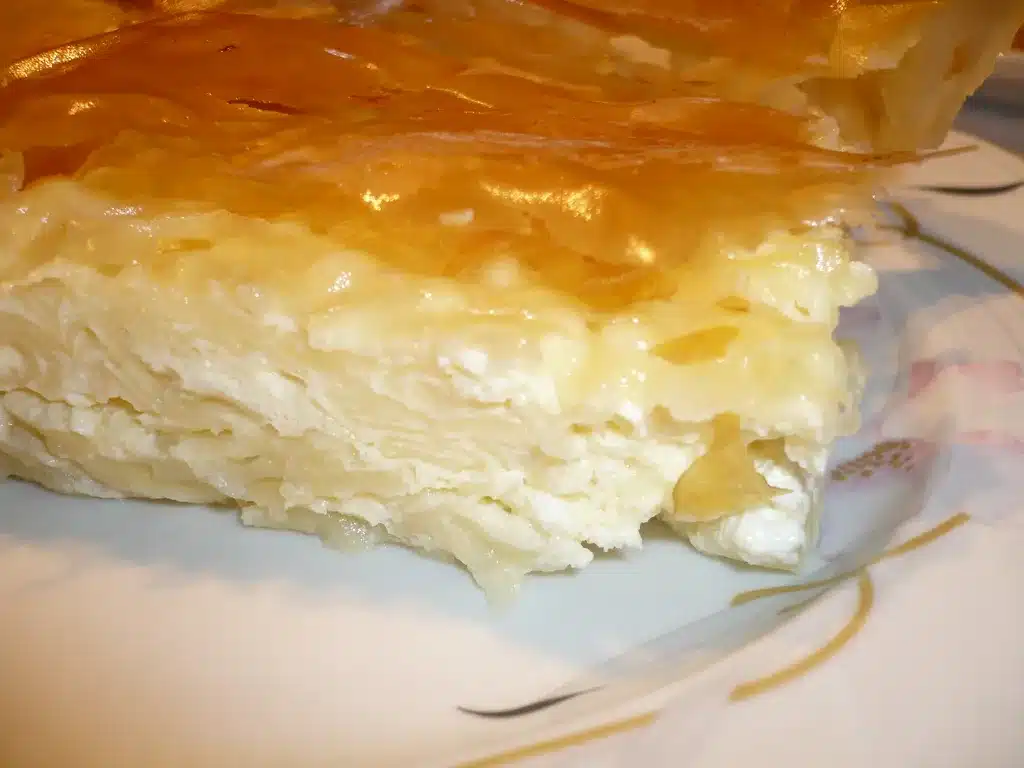
©coolinarika.com
Gibanica
Although common in Croatia, Slovenia, and Macedonia, gibanica is mainly associated with Serbia. It is a traditional pie-like dish that combines phyllo dough (occasionally replaced with yeast dough) with a creamy combination of cheese and eggs.
The most popular version of this versatile pie is called gužvara, meaning crumpled, in which the sheets of phyllo dough are soaked in a creamy mixture of fresh cow’s cheese and eggs. The sheets are then layered and baked in the form of a casserole.
This pie-like dish can be prepared in sweet and savory versions, depending on the region and personal preferences. In Serbia, gibanica is usually paired with yogurt, making a perfect breakfast staple or filling snack. Served sliced, it is also a mainstay on every festive occasion when it is traditionally enjoyed as a cold appetizer.
The best Gibanicas in Belgrade are in Dokolica Bistro and Vuk.
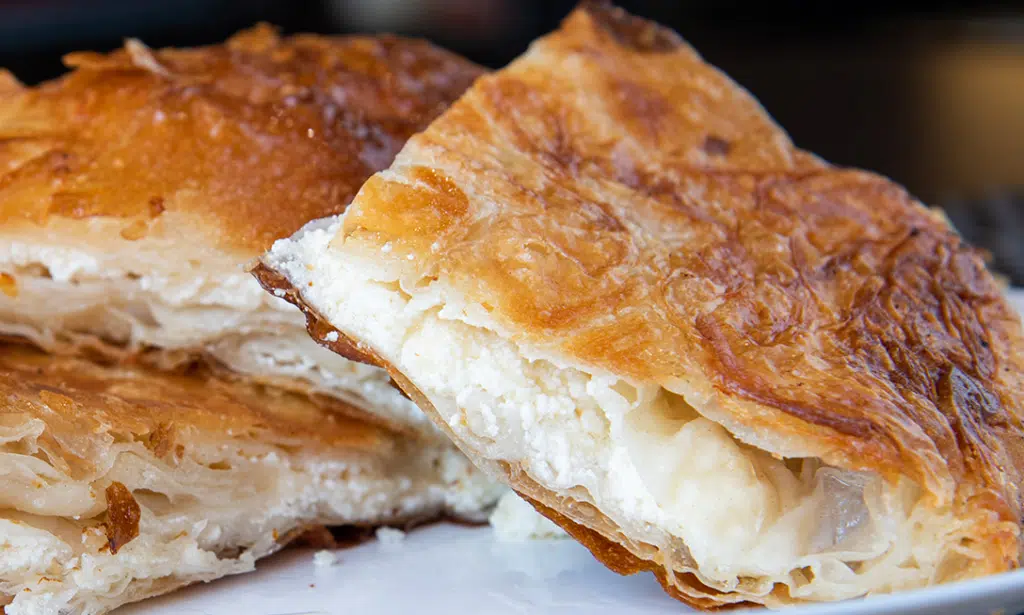
©tasteatlas.com
Burek sa sirom
Burek sa sirom is a phyllo pastry that is round or coil-shaped and filled with a mixture of cheese and eggs. The dough is made with flour, salt, water (and perhaps some oil) and stretched into translucent sheets. The sheets of phyllo dough are stacked in a large tray, and each sheet is sprinkled with grease or oil and mineral water and spread with the cheese and egg filling.
Still, you might have heard that a Burek can only be called a Burek if it’s filled with meat. That is if you live in Bosnia and Herzegovina. But Burek has, in fact, Turkish origins. In Bosnia, Burek (with beef) and other types of similar pies, such as sirnica (cheese) and krumpiruša (potatoes), are usually rolled into a coil, while Croatians and Serbs have a more relaxed approach – Burek can be round and cut into quarters, or rolled into a ring – both shapes are suitable. Both can be called Burek sa sirom (when filled with cheese).
Initially, the Burek was brought to Niš in the 15th century and prepared as a round pie. After World War II, the Burek came to Croatia and Slovenia. Burek sa sirom denotes a round or coil-shaped pastry filled with cheese.
Most importantly, it’s delicious, filling, and a great breakfast staple for many Serbs and Croatians, especially when paired with a refreshing cup of yogurt.
They are serving delicious Burek at Pekara Trpković and Pekara Ljupče.

©belgradeatnight.com
Ćevapi or Ćevapčići
Ćevapi is a popular dish in Serbia and Balkan despite its Turkish origin. These small minced meat sausages are typically made with ground beef or a mixture of beef, veal, or lamb, seasoned with different spices, such as garlic, salt, black pepper, and sometimes paprika or hot red pepper flakes.
After marinating for a few hours, ćevapi is barbecued over charcoal. Traditionally, one dish comprises ten pieces of ćevapi served on a soft, moist, slightly grilled flatbread called lepinja or somun. It is usually accompanied by kajmak, a clotted cream spread, ajvar, roasted red pepper; eggplant relish prevalent in Croatia and Serbia, and raw onions.
Don’t miss eating ćevapi at To je To, Ćevabdžinica Savčić, Tri Šešira, or at Walter Sarajevski Ćevap.
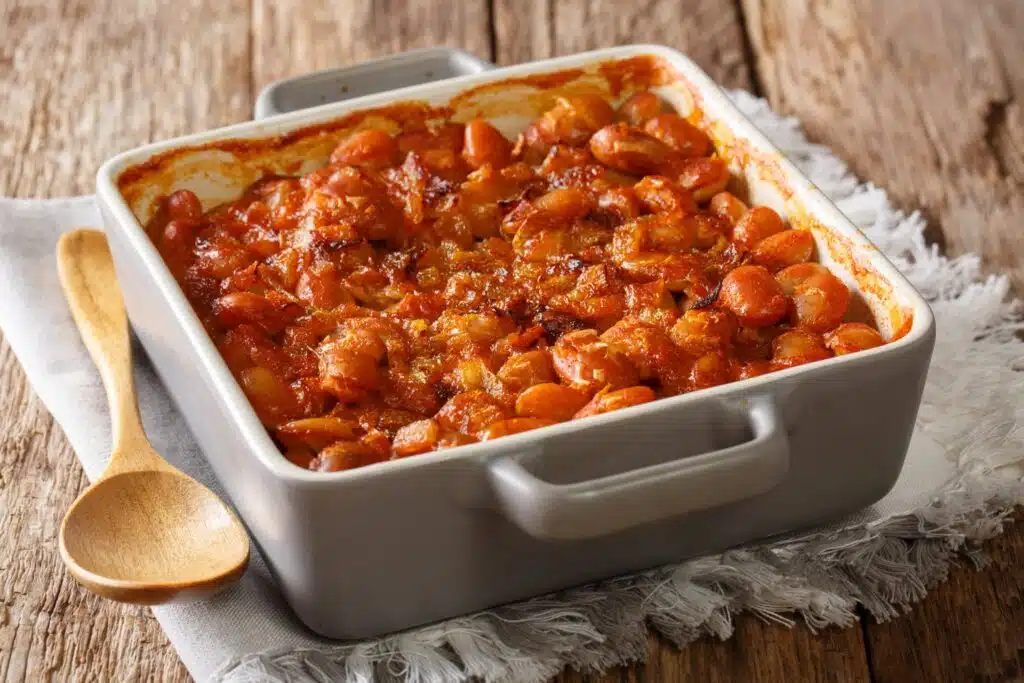
©okusno.je
Prebranac
Prebranac is a Serbian dish of beans baked with onions, Hungarian powdered Paprika, and oil and water. The final result shouldn’t be soupy but slightly dry, with onion-coated beans developing a creamy texture. Originally, prebranac was made by farmers during the cold winter days.
Today, the dish is traditionally served as an accompaniment to main dishes. However, it can also be consumed independently, preferably paired with a slice of crusty bread on the side.
Enjoy tasty Prebranac at Tri Šešira, Zavičaj, and Kafana Question Mark.

©stil.kurir.rs
Srpska salata (Serbian Salad)
Srpska salata (lit. Serbian salad) is a variation of the famous Bulgarian shopska salad. Shopska salad is made with tomatoes, cucumbers, raw or roasted peppers, onions, and salty cheese. Srpska salata is almost precisely the same, but it omits the cheese from the combination.
The vegetables are mixed, then seasoned with salt and pepper and drizzled with oil and vinegar before consumption. This salad is trendy in summer due to its refreshing flavors.
Food critics recommend eating—Serbian salad at Tri Šešira.

©tasteatlas
Gomboce
Gomboce or knedle sa šljivama is a must-try dish in the Balkans, especially in Serbia and Croatia. The dough is made by combining potatoes, eggs, and flour. It’s essential to cook the potatoes on their skin, peel them, and mash them before adding them to the mixture.
Once the dough is ready, it should be rolled and cut into squares. Each square should have a plum placed in the center, and the edges should be folded to create a dumpling. Boil the dumplings and coat them with a mixture of breadcrumbs, sugar, and butter for an unforgettable taste.
So, let’s try some of the best Gomboce at Ferdinand knedle.
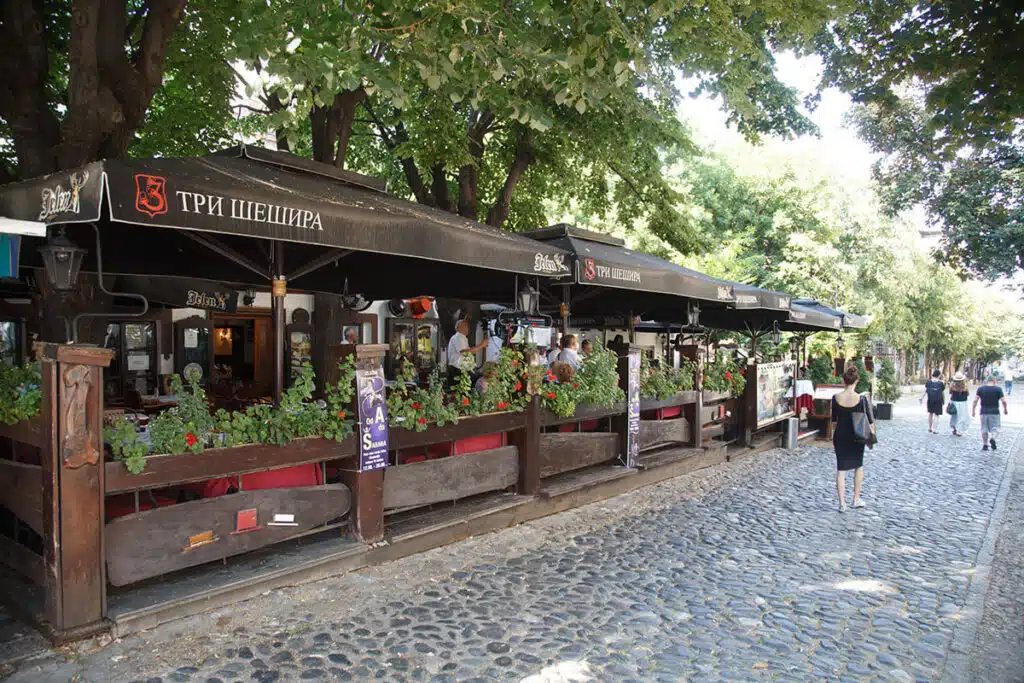
©restoranibeograd.com
Best restaurants in Belgrade
We have sorted a few of the best restaurants and kafanas, which offer (according to food critics) the Best Serbian Food.
- Ambar Belgrade: best for tasting Ajvar, Pljeskavica or Urnebes.
- Tri Šešira: Karođorđeva šnicla, Pljeskavica, Sarma, Ajvar, Prebranac, Ćevapi.
- Kafana Question Mark: Prebranac, Sarma.
- Klub književnika: Sarma
- To je To: Sarajevski ćevapi, Pljeskavica, Sarma.
- Pekara Trpković: Burek
- Papa Joe: Karađorđeva šnicla
- Dokolica Bistro: Gibanica
- Loki: Pljeskavica
- Careva ćuprija: Pasulj
Best Serbian Drinks
In this section, we’ll be discussing both alcoholic and non-alcoholic beverages. Let’s start with the most popular one – coffee. Traditionally, coffee in Serbia refers to a solid and thick Turkish coffee known as “turska kafa.” Sugar is added at the beginning of the brewing process, so it’s best to specify the amount of sweetening you prefer. If you don’t, it will likely come medium sweet (“srednje slatka”). However, cafes may allow you to add sugar if you’re a foreigner. Thanks to its proximity to Italy, most restaurants now have espresso machines, so even small provincial towns can prepare a convincing espresso or cappuccino.
Tea (“čaj”) is also available but is usually relatively weak and watery. If you prefer tea with milk, ask for “sa mlekom”; if you like it with lemon, ask for “sa limunom.” Specialty and herbal teas are also famous, and some city cafes have an excellent selection.
After beer, wines are the second most popular alcoholic drink in Serbia. Most Serbian wines are easy to drink, and some are mouth-watering. The best wines are Prokupac (from the Župa village in southern Serbia), Tamjanika, and Crna Tamjanika (the best wines come from Negotin and Fruška Gora).
While Serbians take pride in their wines, they’re more enthusiastic about the range of alcoholic spirits they produce. Experimenting with these products can be quite an adventure. That’s why we’ll focus on the most popular one, Rakija.
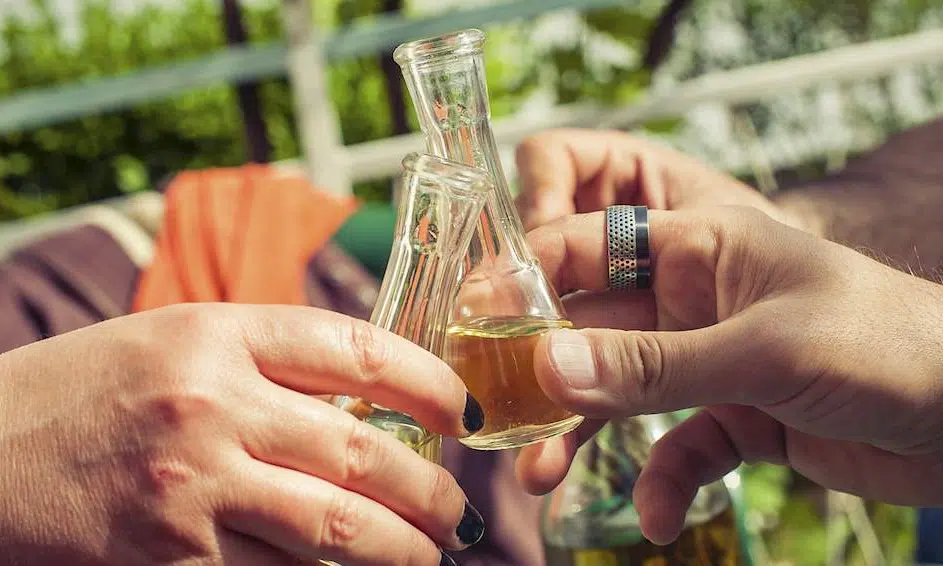
©tasteatlas/Shutter Stock
Rakija
Rakija is a universal term for fruit brandies produced exclusively in several Balkan countries within Southeast Europe. This strong spirit is distilled from different fruits and sometimes flavored or used as a liqueur base. The most common versions are distilled from plums (šljivovica), Williams pears (viljamovka), quinces (dunjevača), apricots (kajsijevača), apples (jabukovača), grapes (lozovača/komovica), and many other fruits.
Typically, this potent spirit has a high alcoholic content of between 40% to 60% ABV. It is usually served neat, well chilled, and in a shot glass, making it a social beverage to be enjoyed with friends or as a welcome drink. Additionally, it is believed to have numerous health benefits, including boosting the immune system and alleviating minor medical problems.
Rakija can be a pure distilled spirit or flavored with herbs and fruits. Many producers use Rakija as a base for liqueurs, sometimes labeled as Rakija, such as orahovac made with walnuts or honey-flavored medica. However, it is essential to note that these are technically liqueurs, not fruit brandies.
Despite its reputation as a crude and harsh drink, many producers are breaking away from its traditional image by creating exceptional labels they promote as sipping drinks. In conclusion, Rakija is a spirit that should be enjoyed in moderation due to its high alcoholic content. Still, it is undoubtedly a flavorful and distinctive drink worth trying.
Final words on the Best Serbian Food
We hope we gave you enough insights to know where and what to look for when visiting Belgrade. However, much of that depends on our preferences and tastes. Therefore, we invite you to share your opinion on what Serbian food you like the most when visiting this beautiful country.
Take a look at
Photo credits:
Feature picture credits: rakijagrill.com



